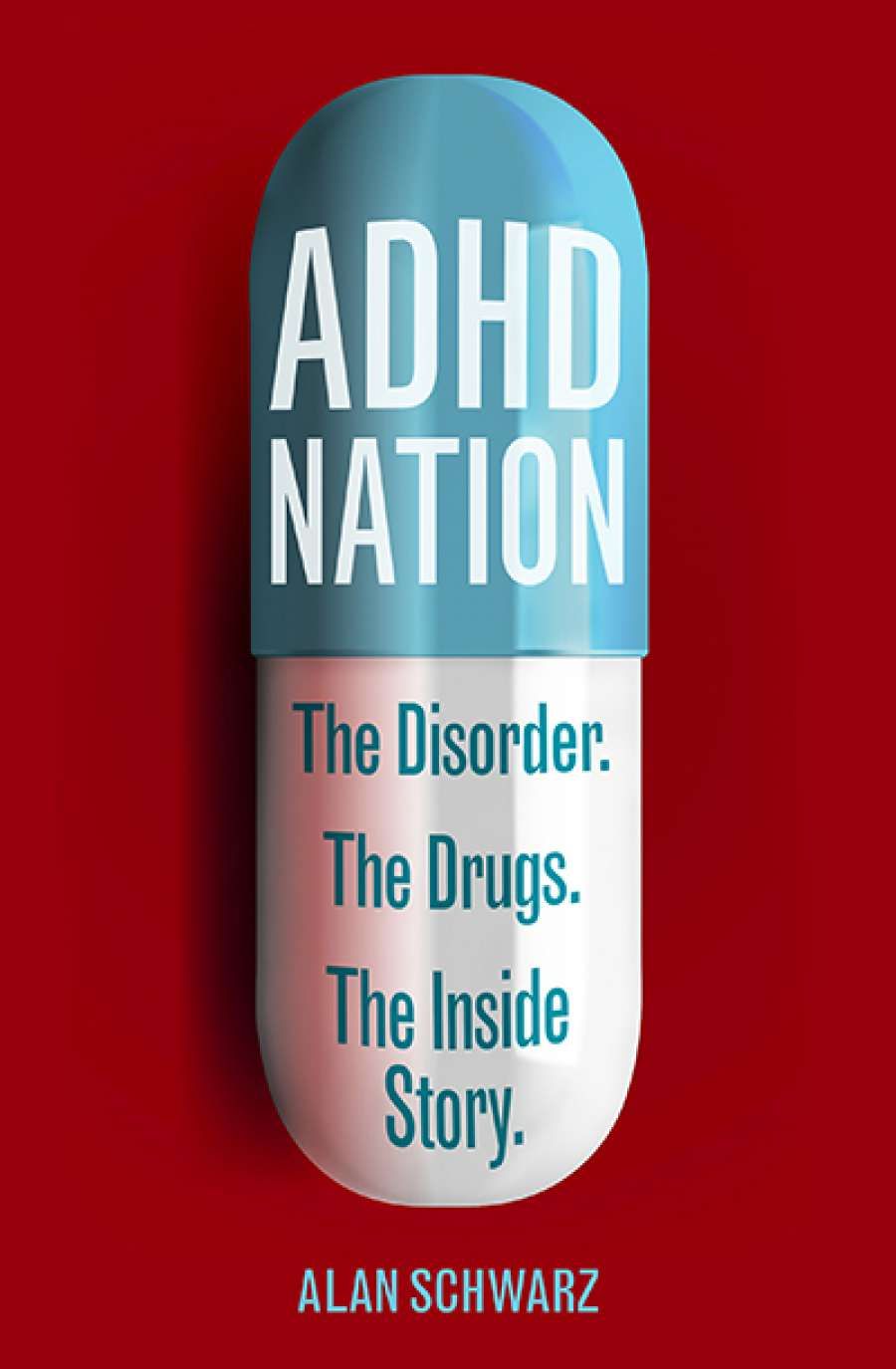
- Free Article: No
- Contents Category: Science and Technology
- Custom Article Title: Nick Haslam reviews 'ADHD Nation: The disorder. The drugs. The inside story.' by Alan Schwarz
- Custom Highlight Text:
The spectrum of opinion on attention deficit hyperactivity disorder – ADHD in the acronym-crazed world of psychiatry – runs from the firiest red to the deepest purple ...
- Book 1 Title: ADHD Nation
- Book 1 Subtitle: The disorder. The drugs. The inside story
- Book 1 Biblio: Hachette, $35 pb, 340 pp, 9781408706572
The villains of this book may be a few multinationals and some prominent psychiatrists, but the main characters are the drugs themselves, whose early lives are tales of misdirection. Benzedrine was initially developed to treat asthma and nasal congestion, and only later found a role in treating childhood attention problems. Ritalin – named after the inventor’s wife, Rita – was intended to treat narcolepsy, depression, and senility. Adderall existed first as the appetite suppressant Obetrol. The apparent paradox of treating excessive activity and flighty attention with stimulants aside, these amphetamines and amphetamine-like compounds can work wonders on some people with ADHD. Concentration sharpens, fidgeting and distraction diminish, and schoolwork becomes manageable.
These therapeutic benefits must be set against several troubling costs, however, and it is here that Schwarz is especially compelling. Stimulant medications occasionally have significant side effects, but more importantly they have great potential for abuse. Contrary to the widespread belief that these drugs simply level out chemically imbalanced brains, they can also improve concentration and dissolve fatigue among people without ADHD. To an alarming degree on some US college campuses, and increasingly here as well, these stimulants are openly shopped and popped by students seeking a dose of cognitive enhancement to get them through their exams and final papers. Besides these rare side effects and common abuses, stimulants can also be highly addictive. Schwarz presents vivid profiles of young people who have become dependent on their medication and, more controversially, who may have been led into the abuse of illicit drugs through the stimulant gateway.
The stubborn refusal of many experts to appreciate the dark sides of stimulant medication angers Schwarz, but the tendency for pharmaceutical companies to overlook them does not surprise him. The most devastating revelation of his book is the ingenuity with which they have steadily enlarged the markets for their products. ADHD was initially understood as a disorder of young boys, often emerging when they first encountered the constraints of formal schooling and declining as their prefrontal cortex ripened on its spinal vine. Over time, the disorder expanded its territory. Increasingly, ADHD was diagnosed in adolescents and later still viewed not as a transient condition of the young but as a lifelong affliction, requiring medication of course. Moving in the other direction, research in the United States has uncovered troubling evidence of stimulants being prescribed to toddlers. The potential market for these drugs was also swelled by the suggestion that ADHD was underdiagnosed in girls, who were less likely than boys to behave ‘hyperkinetically’, but might still be quietly lost in a fog of distracted daydreaminess. As if expanding ADHD’s reach was not enough, enterprising marketers and researchers have brought into being a new condition, binge eating disorder, which is to be treated by the same medications. They are now in the process of creating a new disorder of attention, the very relatable ‘sluggish cognitive tempo’.
 Alan SchwarzThe expansion of the stimulant market has been accompanied by steep rises in the prevalence of the ADHD diagnosis, abetted by gradual shifts in how it is defined and assessed. Schwarz notes with alarm how the condition was thought to affect three per cent of children when it was first formally recognised in 1980, but this estimate has steadily risen to eleven per cent. He attributes this inflation not to societal change or other factors that might legitimately change mind and behaviour on a macro scale – diet, digital technologies – but to rampant over-diagnosis. With the encouragement of ‘pharmaceutical evangelists’, quick-and-dirty assessments, enabled by simple-minded checklists, are prescribing medications to people who are neither impaired nor unwell.
Alan SchwarzThe expansion of the stimulant market has been accompanied by steep rises in the prevalence of the ADHD diagnosis, abetted by gradual shifts in how it is defined and assessed. Schwarz notes with alarm how the condition was thought to affect three per cent of children when it was first formally recognised in 1980, but this estimate has steadily risen to eleven per cent. He attributes this inflation not to societal change or other factors that might legitimately change mind and behaviour on a macro scale – diet, digital technologies – but to rampant over-diagnosis. With the encouragement of ‘pharmaceutical evangelists’, quick-and-dirty assessments, enabled by simple-minded checklists, are prescribing medications to people who are neither impaired nor unwell.
ADHD Nation is primarily a critique of the entangled relationship of psychiatry and the pharmaceutical industry in the United States. Some things are different here. Rates of ADHD among Australian children are significantly lower, and rates of stimulant prescription and off-label use substantially so. However, it would be a mistake to read Schwarz’s powerful book as a travel guide to an exotic land. ‘Our culture’s handling of the disorder could very well be diagnosed with ADHD,’ he writes, and because US cultural trends have a tendency to globalise, we need to be attentive.


Comments powered by CComment